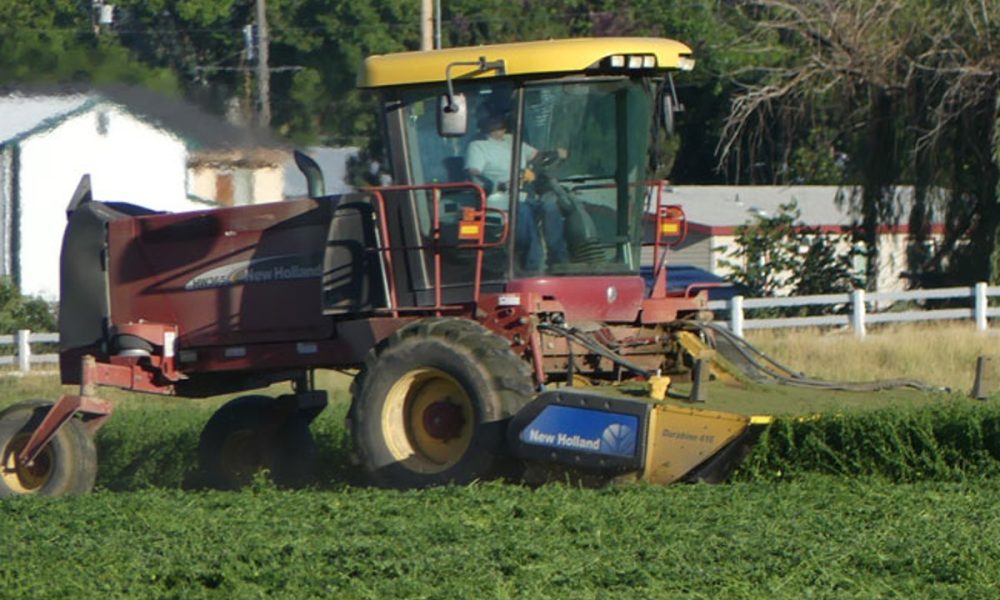
In 2017 local farmers harvested more than 250,000 tons of alfalfa. Now, more than ever, technology is a key piece to the traditional hay season. (The Enterprise/Pat Caldwell).
VALE – The cutting of alfalfa is a summer tradition in Malheur County and technology and a global market have changed the business in subtle and interesting ways.
So far, this year the alfalfa yields appear to be good, according to hay producers and the county extension office.
In 2017, Malheur County produced more than 250,000 tons of alfalfa worth just over $43 million. Only Klamath and Jefferson counties produced more. Area hay producers encountered a wet spring this year and then frequent thunderstorms this month that impacted quality.
“We have either got a lot of hay wet or put off a lot of cutting. Both make the quality go down. Every day it sits, it goes downhill,” said Vale farmer Jeff Burkhardt.
According to the U.S. Department of Agriculture, county alfalfa farmers produced on average 4.9 tons of alfalfa per acre in 2017.
More than 51,000 acres were harvested that year.
Fickle weather can mean fields are cut later than normal. That isn’t good either, said Burkhardt.
“It starts going from a vegetative plant to a reproduction plant, which changes the fibers. The proteins get lower,” said Burkhardt.
County alfalfa farmer Chris Payne agreed Mother Nature was uncooperative this year.
“It’s been a rough spring. It seems like in May there is usually a gap we can get some hay up. But this year it seems like every fourth day we had rain,” said Payne.
Payne said the quality for his first cutting wasn’t great.
“But the second cutting is looking good, which is encouraging,” said Payne.
Typically, county farmers finish five cuttings of alfalfa between May and September.
The most recent federal market survey for alfalfa in April showed the price at $180 per ton.
Payne said while the market is up slightly, current prices aren’t in line with the federal statistics. He said alfalfa has been going for $140 a ton.
Payne does custom harvesting and cuts his personal alfalfa acreage, putting up about 10,000 tons in a year.
Commodity markets always drive prices but now technology plays a larger role than ever.
“Hay is so complicated. You need an engineering degree to be able to do this right anymore,” Burkhardt joked.
One factor driving the high-tech aspect of alfalfa farming is the desire of consumers to know where products come from. Especially in foreign markets, said Burkhardt, customers want to know where products were harvested and how.
“Just like everything in ag, they want to know the point of source,” said Burkhardt.
Burkhardt said farmers now use such high-tech resources as computer chips placed into individual bales of hay that track a bale “all the way through the system.”
He said the computer chip can “even tell you where the second tie was tied when it was baled. A lot of export people, Japan and stuff, they like knowing more specifics all the time,” said Burkhardt.
Payne utilizes a new steamer system when hay is baled.
“It goes between the tractor and the baler,” said Payne.The steamer, he said, creates its own dew on the cut alfalfa. Mother Nature covers cut hay with dew but not in a uniform pattern.
“When you used to bale, you baled in the middle of the night because you want dew to make the hay tough. The leaves stick to the stems and the leaves are where the nutrients are. But dew is never perfect. It’s always too dry or too wet,” said Payne.
With the steamer, the windrows of alfalfa receive an even amount of dew.
“We inject steam into the windrows as the hay is being picked up off the ground. It happens instantaneously. It hooks those leaves to the stem and makes a higher quality product because you are getting all those nutrients into the bale,” said Payne.
Quality bales are crucial, both men said, especially because they both supply dairies.
“I have to be really specific about getting the quality as high as I can,” said Burkhardt.
Dairies seek the high-quality alfalfa for its high energy content, which in turn sustains the production of milk.
While the hay market is solid now, it could improve. That’s because of events far away from Malheur County, said extension agent Stuart Reitz.
“As things shift around the U.S. there is a potential for a pick up. The dairy industry is still strong and there are a lot of exports to Saudi Arabia and China,” said Reitz.
Reitz said Saudi Arabia, for example, decided to divert more water for food production.
“They are investing more in imported hay,” said Reitz.
Payne said the hay export market is a “little shaky” right now “due to some trade disagreements that our government is having with China. But I think it is one of those things that will work itself out in a few months.”
Reporter Pat Caldwell: [email protected] or 541-473-3377.




